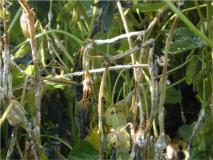WHITE MOLD: IS IT WORTH TALKING ABOUT?
Mar 22, 2021

“As we move into 2021 and make management decisions, let’s take a moment to revisit white mold. 2020 showed very little white mold and it is easy to forget about it,” said John Swanson, Federated agronomist at the Ogilvie location. However, since white mold tends to rear its head about every other year, 2021 “has the potential to be bad,” he said.
“We are likely rotating back to fields that have high levels of sclerotia,” said Swanson, and managing the fungi takes a season-long approach.
White mold pressure has been high in recent years, thanks to the weather. Thus, to guard against the prospect, “plant the best genetics you can,” said Swanson. Plant seed with a high tolerance level for white mold. Heads Up seed treatment is a good option, too, with its systemic acquired resistance that stimulates the defensive abilities of the plant upon germination. (See related article.)
At issue is the reality that white mold negatively impacts yields before it is detected, and “it is a disease of our best soybeans,” said Swanson. It’s important to target fields with history of white mold, as well as early planted soybeans or soybeans on fields with high fertility. Swanson noted these additional considerations in the fight against white mold:
- - Avoid planting in narrow rows.
- - Avoid high plant populations on fields with white mold history.
- - Be wary of cool summers with wet conditions.
- - Consistently scout soybean fields for flowers, especially as June 21 approaches.
- - The shortest night of the year triggers indeterminate soybean flowering. White mold fungicide must be applied at R1 or beginning bloom, which is one open flower at any node on the main stem.
- - As soon as flowers appear, spray a fungicide.
- - White mold enters the soybean plants through the senescing flowers, “so it’s critical to have the plant protected before the flowers begin senescing,” said Swanson.
- - Federated recommends Aproach® or Endura® fungicide.
If white mold is an issue this season, Swanson recommends using Contans®, post harvest. Contans is a biological fungicide that destroys the sclerotia, reducing it 80-85% each year it is in the soil. “This means the longer it is in the soil before you go back to soybeans, the better,” he said.
Contans is a good investment if you lose 10 bu./ac. in yields – that’s a $100/ac. loss (or possibly more) at today’s soybean prices. Applying Contans may be an expensive option, but it still offers good ROI, “especially if you have major issues with white mold,” he added. It’s a long-term investment that will help eliminate sclerotia, reducing the risk of white mold in the future.
Talk to your Federated Agronomist to determine how you need to prepare for white mold this year.